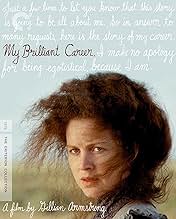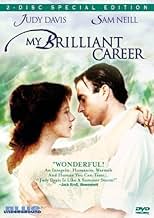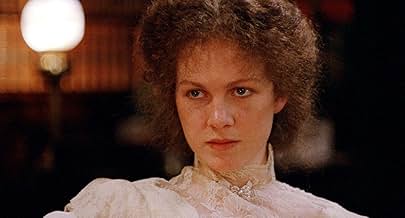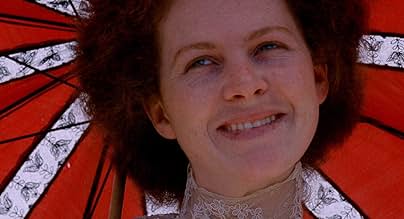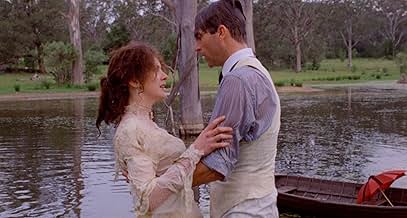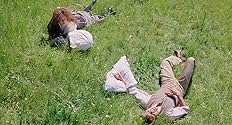CALIFICACIÓN DE IMDb
7.1/10
5.1 k
TU CALIFICACIÓN
Una joven orgullosa en la Australia de principios del siglo XX debe elegir entre el matrimonio y la independencia.Una joven orgullosa en la Australia de principios del siglo XX debe elegir entre el matrimonio y la independencia.Una joven orgullosa en la Australia de principios del siglo XX debe elegir entre el matrimonio y la independencia.
- Dirección
- Guionistas
- Elenco
- Nominado a 1 premio Óscar
- 11 premios ganados y 8 nominaciones en total
- Dirección
- Guionistas
- Todo el elenco y el equipo
- Producción, taquilla y más en IMDbPro
Opiniones destacadas
10wse
My mother took me to see this film when I was ten, the year before she died. It changed my entire perspective on the world, set me free from the constraints of fairy tales and inspired me to do something worthwhile with my life (write). I've seen it a few times since then, and found it improved in pace with my understanding.
Apparently Judy Davis didn't like this character or sympathize with her. All I can say is that I'm glad she went ahead and took the role anyway. Sybylla is like Cinderella with a twist worthy of M. Night Shymalan.
The film is sometimes beautiful and lyrical, sometimes depressing and ugly. At all times it is believable because the forces driving Sybylla transcend time and place: creativity and independence. This film taught me that a gilded cage is still a cage.
Even twenty odd years after I first saw it, this film makes me want to cheer. Gillian Armstrong, if you're out there, thank you!
Apparently Judy Davis didn't like this character or sympathize with her. All I can say is that I'm glad she went ahead and took the role anyway. Sybylla is like Cinderella with a twist worthy of M. Night Shymalan.
The film is sometimes beautiful and lyrical, sometimes depressing and ugly. At all times it is believable because the forces driving Sybylla transcend time and place: creativity and independence. This film taught me that a gilded cage is still a cage.
Even twenty odd years after I first saw it, this film makes me want to cheer. Gillian Armstrong, if you're out there, thank you!
Sometimes a life in film brings an experience like this. Its oddly tense in some dimensions and relaxed in others and the balance between the two seems distinctly Australian. I hadn't seen this when it was new, and I'm glad. Seeing a great film for the first time is a distinct pleasure.
I can think of only two similar pleasures in life.
Reviewers often focus on the story; its the common currency for discussion. The interesting fact behind the power of this movie is that the story is incoherent, poorly developed. There are a few main characters and none of them are attached to what are considered necessities for storytelling. They aren't introduced, we see them only through the effect of their presence. They don't develop. They influence nothing.
The main character is presented as a sort of Jane Austen both an Austen woman encouraged to marry, and Austen herself as a sort of author-in-her-own-book, like we saw in the 1999 film of Mansfield Park. But the odd thing is that we have Austen in Australia, the role and all the expectations without the baroque mechanics of society swirling around. Instead we get cows and sheep.
And emptiness, a cinematic vastness that even the US hasn't yet produced, despite Terence Malick.
So the incompleteness of the story is part of the genius of the thing. Our heroine doesn't have an Austenian future, instead becomes a backcountry Louisa May Alcott or George Sand. Indeed, Davis did go on to play Sand and Anderson went on to direct "Little Women." What our filmmaker has done is create a story where we subconsciously notice something is missing. And then she fills it with two things, this translucent actress and a similarly translucent open landscape.
First the landscape. Watch the opening of this. Its genius, shooting from outside in, peering in through windows and doors while we see literally the story beginning to be written. Then we shoot from the inside through the same windows out and see a dust tempest beginning.
This notion of space, inadequate enclosure, book and heroine conflated into them and weaving through them was copied after a fashion in the opening for the 2005 "Pride and Prejudice." Here, it is fresh, original, shocking. Effective, even life-affirming.
You can see a similar master vision in how the ending is shaped. We see our woman, a best friend by this time, going to mail her book to us. She approaches the fence and her dog scurries under, unconstrained by fences. Its a small thing, but by then we've become aware of how wonderfully our hidden woman behind the camera has shaped everything so minutely. That dog moves under the gate naturally, using a gait and hole that can only have come through hundreds of such exits. I have no idea how Anderson did it.
And now to Ms. Davis. Over time you pick things from the film vocabulary that you cleave to, things that naturally tip into the bucket of your soul. One of these for me is a certain type of folded acting I've noticed in Australian actresses. Blanchett, Winslet are the ones I follow deeply.
But you can see it here and I imagine that this is the first appearance of the style in a competent film. In my own historiography, Judy Davis invented it and does so here. If you watch her manner, you can see Cate. The style is what I call folded, where we get both the character and a higher level communication from the actor about the character.
We have a few folded actresses. What's even rarer is when the actress is intelligent and skilled enough to place that higher fold in the center of the filmmaker's intention. It happens here. Its beautiful, on a simpler level echoing the fact that we see a book, its making, and various considerations about the making of the book.
Because it is this sort of translucent folding, we see Cate when we see Judy.
You won't soon forget that.
I'm putting this on my list of films you really must see. Readers may be shocked. I only allow myself two from any given years and this year gave us "Alien," "Apocalypse Now," "Manhattan," and "Tree of Wooden Clogs," all of which are bumped by this. But this will change you, a female Herzog, unHerzog.
Now if I can only see "High Tide."
Ted's Evaluation -- 4 of 3: Every cineliterate person should experience this.
I can think of only two similar pleasures in life.
Reviewers often focus on the story; its the common currency for discussion. The interesting fact behind the power of this movie is that the story is incoherent, poorly developed. There are a few main characters and none of them are attached to what are considered necessities for storytelling. They aren't introduced, we see them only through the effect of their presence. They don't develop. They influence nothing.
The main character is presented as a sort of Jane Austen both an Austen woman encouraged to marry, and Austen herself as a sort of author-in-her-own-book, like we saw in the 1999 film of Mansfield Park. But the odd thing is that we have Austen in Australia, the role and all the expectations without the baroque mechanics of society swirling around. Instead we get cows and sheep.
And emptiness, a cinematic vastness that even the US hasn't yet produced, despite Terence Malick.
So the incompleteness of the story is part of the genius of the thing. Our heroine doesn't have an Austenian future, instead becomes a backcountry Louisa May Alcott or George Sand. Indeed, Davis did go on to play Sand and Anderson went on to direct "Little Women." What our filmmaker has done is create a story where we subconsciously notice something is missing. And then she fills it with two things, this translucent actress and a similarly translucent open landscape.
First the landscape. Watch the opening of this. Its genius, shooting from outside in, peering in through windows and doors while we see literally the story beginning to be written. Then we shoot from the inside through the same windows out and see a dust tempest beginning.
This notion of space, inadequate enclosure, book and heroine conflated into them and weaving through them was copied after a fashion in the opening for the 2005 "Pride and Prejudice." Here, it is fresh, original, shocking. Effective, even life-affirming.
You can see a similar master vision in how the ending is shaped. We see our woman, a best friend by this time, going to mail her book to us. She approaches the fence and her dog scurries under, unconstrained by fences. Its a small thing, but by then we've become aware of how wonderfully our hidden woman behind the camera has shaped everything so minutely. That dog moves under the gate naturally, using a gait and hole that can only have come through hundreds of such exits. I have no idea how Anderson did it.
And now to Ms. Davis. Over time you pick things from the film vocabulary that you cleave to, things that naturally tip into the bucket of your soul. One of these for me is a certain type of folded acting I've noticed in Australian actresses. Blanchett, Winslet are the ones I follow deeply.
But you can see it here and I imagine that this is the first appearance of the style in a competent film. In my own historiography, Judy Davis invented it and does so here. If you watch her manner, you can see Cate. The style is what I call folded, where we get both the character and a higher level communication from the actor about the character.
We have a few folded actresses. What's even rarer is when the actress is intelligent and skilled enough to place that higher fold in the center of the filmmaker's intention. It happens here. Its beautiful, on a simpler level echoing the fact that we see a book, its making, and various considerations about the making of the book.
Because it is this sort of translucent folding, we see Cate when we see Judy.
You won't soon forget that.
I'm putting this on my list of films you really must see. Readers may be shocked. I only allow myself two from any given years and this year gave us "Alien," "Apocalypse Now," "Manhattan," and "Tree of Wooden Clogs," all of which are bumped by this. But this will change you, a female Herzog, unHerzog.
Now if I can only see "High Tide."
Ted's Evaluation -- 4 of 3: Every cineliterate person should experience this.
Judy Davis is Sybylla, a girl of the Australian outback around 1909. As portrayed by Davis, in her breakthrough role, Sybylla is a font of boundless energy wanting desperately to escape the backwardness of her young life. Sam Neill, also in one of the significant early roles of his career, is likewise charming as the young man who presents her with a tempting alternative to her ambition to become a writer and escape the frontier life forever.
This is not a great or epic story, certainly, but it is a quiet, rewarding story of a young woman's quest for a better life. A worthy entry among the films that marked the ascendancy of the "Australian Renaissance" in film-making during the 1970s; director Armstrong would go on to make such films as "Mrs. Soffel" and the 1994 "Little Women."
This is not a great or epic story, certainly, but it is a quiet, rewarding story of a young woman's quest for a better life. A worthy entry among the films that marked the ascendancy of the "Australian Renaissance" in film-making during the 1970s; director Armstrong would go on to make such films as "Mrs. Soffel" and the 1994 "Little Women."
Usually I'm not too interested in these kinds of films, but i found myself becoming involved in the characters and their lives. The movie was very well done, and it explores many of the social gender roles that are still applicable today.
It is a funny, yet serious movie, that has some deep undertones.
I would recommend watching it.
It is a funny, yet serious movie, that has some deep undertones.
I would recommend watching it.
If not to see a young Sam Niel or for the gorgeous landscapes of Australia that set the film, see this movie for an interesting viewpoint on feminism and the outback all in one. The main character, Sybylla, is constantly insulted by her alleged friends and family, though they don't intend it directly. Her character's flaky-ness doesn't help her plight as a female in a society hell-bent on marrying her off, but the character's story is worth renting this for.
¿Sabías que…?
- TriviaJudy Davis learned the piano for her role in this film and played her own piano solos. Davis is credited for piano playing in the closing credits.
- Citas
[first lines]
Sybylla: Possum Gully, Australia. 1897. Dear fellow countrymen, just a few lines to let you know that this story is going to be all about me. So, in answer to many requests, here is the story of my career... here is the story, of my career... my *brilliant* career. I make no apology for being egotistical... because I am!
- ConexionesFeatured in Ciné regards: Judy Davis (1980)
Selecciones populares
Inicia sesión para calificar y agrega a la lista de videos para obtener recomendaciones personalizadas
- How long is My Brilliant Career?Con tecnología de Alexa
Detalles
- Fecha de lanzamiento
- País de origen
- Idioma
- También se conoce como
- Meine brillante Karriere
- Locaciones de filmación
- Productoras
- Ver más créditos de la compañía en IMDbPro
Taquilla
- Presupuesto
- AUD 800,000 (estimado)
- Tiempo de ejecución1 hora 40 minutos
- Mezcla de sonido
- Relación de aspecto
- 1.85 : 1
Contribuir a esta página
Sugiere una edición o agrega el contenido que falta


